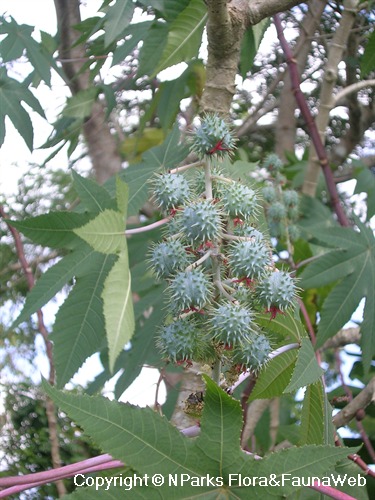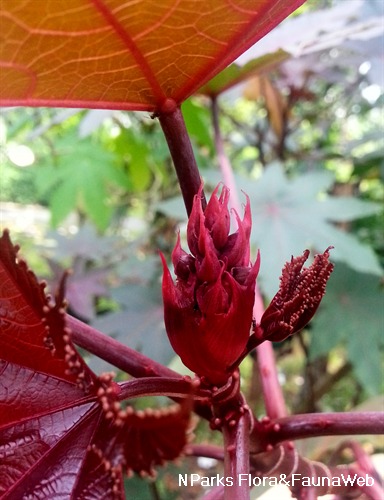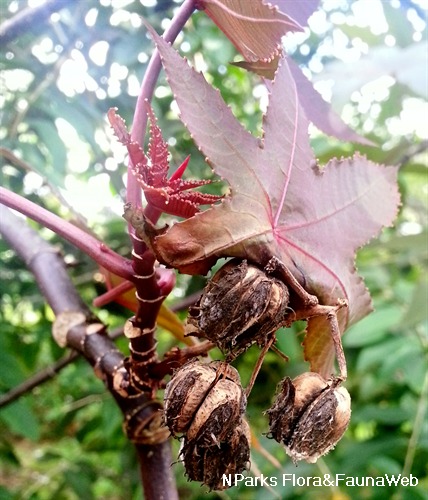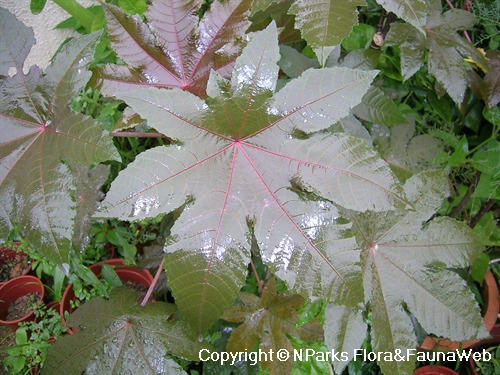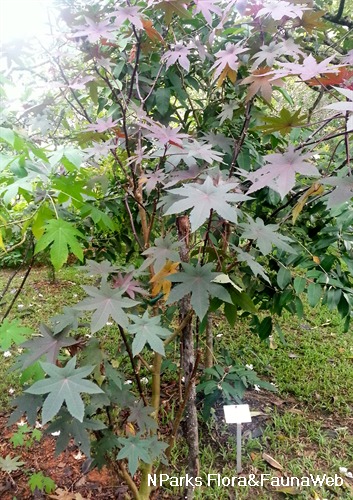
Back
Ricinus communis L.
| Family Name: | Euphorbiaceae |
| Common Name: | Castor Oil Bean, Castor Oil Plant, Palma Christi, Castor Bean Plant, Jarak, 蓖麻 |
Name
Classifications and Characteristics
| Plant Division | Angiosperms (Flowering Seed Plants) (Dicotyledon) |
|---|---|
| Plant Growth Form | Herbaceous Plant |
| Lifespan (in Singapore) | Perennial |
| Mode of Nutrition | Autotrophic |
| Plant Shape | Open |
Biogeography
| Native Distribution | Africa, India |
|---|---|
| Native Habitat | Terrestrial |
| Preferred Climate Zone | Tropical, Temperate |
| Local Conservation Status | Non-native (Spontaneous (Naturalised)) |
Description and Ethnobotany
| Growth Form | A fast growing shrub, can reach the size of a small tree of about 12 m. |
|---|---|
| Roots | Tap root with prominent lateral roots. |
| Foliage | Leaves glossy, 15 - 45 cm long, long petiole, alternately arranged along the stems. Leaf is palmately lobed with 5 - 12 lobes, and toothed margins. Young foliage are reddish purple, gradually change to dark green as they mature. |
| Flowers | Numerous in long panicle-like inflorescence with male flowers at the base while female flower at the tips; petals absent in both sexes. Male flowers are yellowish green with creamy stamens while female flowers have red stigmas. |
| Fruit | A globose capsule 2.5 cm in diameter, on an elongated pedicel, usually spiny, green turning brown on ripening, indehiscent in modern cultivars, usually containing 3 seeds. Seeds are oval and shiny. |
| Habitat | Found in disturbed areas, sand dunes, road margins and shrublands. |
| Etymology | The genus Ricinus means tick, which refers to the appearance of the caruncled and coloured seeds that resemble ticks. The specific epithet communis means growing in clumps or common. |
| Ethnobotanical Uses | Medicinal: The plant is traditionally used to treat abdominal discomfort and constipation. It is also used to treat fevers, bronchitis, coughs and skin diseases. Others: The castor beans are often made into necklaces and bracelets. Castor oil has commercial value for making soap, margarine, lubricants and paints. |
Landscaping Features
| Desirable Plant Features | Ornamental Foliage |
|---|---|
| Landscape Uses | General |
| Usage Hazard - Cons | Toxic Upon Ingestion |
Fauna, Pollination and Dispersal
| Fauna Pollination Dispersal Associated Fauna | Butterfly Host Plant |
|---|---|
| Seed or Spore Dispersal | Biotic (Fauna) |
Plant Care and Propagation
| Light Preference | Full Sun |
|---|---|
| Water Preference | Moderate Water |
| Plant Growth Rate | Fast |
| Rootzone Tolerance | Well-Drained Soils |
| Diseases | Susceptible to leaf spot disease. |
| Propagation Method | Seed |
Foliar
| Foliage Retention | Evergreen |
|---|---|
| Mature Foliage Colour(s) | Green, Red |
| Mature Foliage Texture(s) | Glossy / Shiny |
| Prominent Young Flush Colour(s) | Red |
| Young Flush Texture(s) | Glossy / Shiny |
| Foliar Type | Simple / Unifoliate |
| Foliar Arrangement Along Stem | Alternate |
| Foliar Attachment to Stem | Petiolate |
| Foliar Shape(s) | Non-Palm Foliage (Orbicular / Round) |
| Foliar Venation | Pinnate / Net |
| Foliar Margin | Serrate / Toothed, Palmately Lobed |
| Leaf Area Index (LAI) for Green Plot Ratio | 4.5 (Shrub & Groundcover - Dicot) |
Floral (Angiosperm)
| Flower & Plant Sexuality | Unisexual Flowers , Monoecious |
| Flower Colour(s) | Green |
|---|
| Flower Grouping | Cluster / Inflorescence |
| Flower Location | Axillary, Terminal |
| Inflorescence Type | Panicle |
Fruit, Seed and Spore
| Mature Fruit Colour(s) | Brown |
|---|---|
| Mature Fruit Texture(s) | Glossy / Shiny |
| Fruit Classification | Simple Fruit |
| Fruit Type | |
| Mature Seed Colour(s) | Black, Brown, Red, Silver / Grey, White, Yellow / Golden |
| Seed Quantity Per Fruit | Few (1-5) |
Image Repository
Others
| Master ID | 1096 |
|---|---|
| Species ID | 2389 |
| Flora Disclaimer | The information in this website has been compiled from reliable sources, such as reference works on medicinal plants. It is not a substitute for medical advice or treatment and NParks does not purport to provide any medical advice. Readers should always consult his/her physician before using or consuming a plant for medicinal purposes. |

